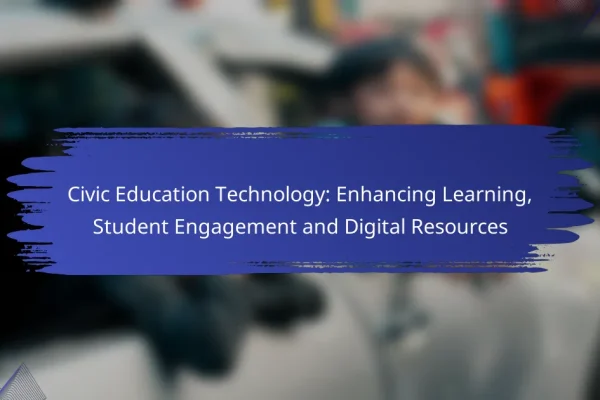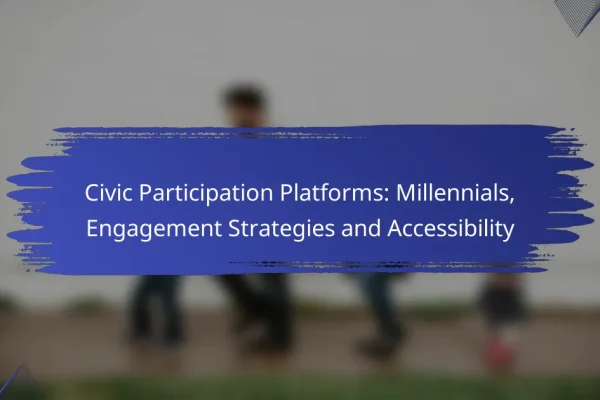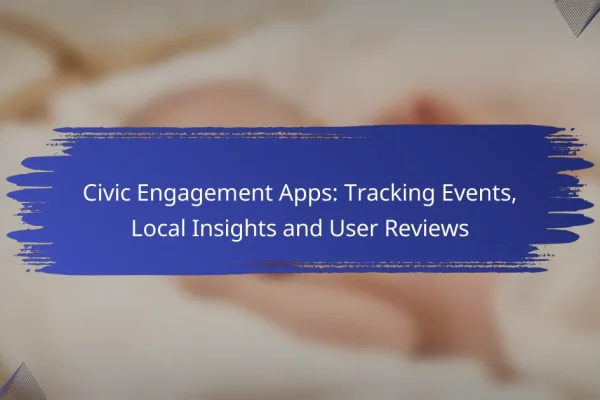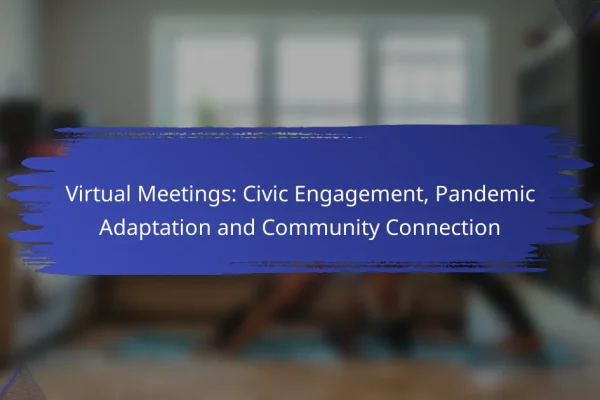How is technology enhancing civic engagement in the United States?
Technology is significantly enhancing civic engagement in the United States by providing citizens with easier access to information, improving communication channels, and enabling data-driven decision making. These advancements empower individuals to participate more actively in their communities and influence local governance.
Increased access to information
Technology has made vast amounts of information readily available to the public, allowing citizens to stay informed about local issues, government initiatives, and civic opportunities. Online platforms, social media, and mobile applications serve as valuable resources for accessing news, policy updates, and community events.
For instance, local government websites often publish meeting agendas, budgets, and public records, making it easier for residents to understand how decisions are made. This transparency fosters a more informed electorate, which is crucial for effective civic participation.
Improved communication channels
Digital tools have transformed how citizens communicate with their elected representatives and each other. Social media platforms, email newsletters, and community forums facilitate direct dialogue, allowing constituents to voice their opinions and concerns more effectively.
Moreover, many local governments utilize apps and websites to gather feedback from residents on various issues, creating a two-way communication channel. This engagement helps officials gauge public sentiment and adjust policies accordingly, enhancing responsiveness to community needs.
Data-driven decision making
Data analytics plays a critical role in modern civic engagement by enabling governments to make informed decisions based on community needs and preferences. By analyzing data from surveys, social media interactions, and public feedback, officials can identify trends and prioritize initiatives that resonate with constituents.
For example, cities may use data to assess the effectiveness of public services or to allocate resources more efficiently. This approach not only improves service delivery but also encourages greater public trust in government actions, as citizens see their input reflected in policy outcomes.
What are the best platforms for civic engagement?
The best platforms for civic engagement include Nextdoor, Facebook, and Change.org, each serving distinct purposes for community interaction and activism. These platforms facilitate local discussions, community organizing, and petitioning, making it easier for citizens to participate in civic life.
Nextdoor for local discussions
Nextdoor is designed specifically for neighborhoods, allowing residents to connect and discuss local issues. Users can share information about community events, safety concerns, and recommendations for local services.
To maximize engagement on Nextdoor, ensure your profile is complete and actively participate in discussions. Avoid spamming or posting irrelevant content, as this can lead to negative feedback from neighbors.
Facebook for community organizing
Facebook is a versatile platform for organizing community events and mobilizing support for causes. Groups can be created for specific initiatives, allowing members to share updates, coordinate efforts, and rally participants.
When using Facebook for organizing, clearly define the group’s purpose and establish guidelines for respectful communication. Regularly update members and encourage them to invite others to broaden the reach of your initiative.
Change.org for petitions
Change.org is a popular platform for creating and signing petitions aimed at effecting change on various issues. Users can easily draft petitions, share them through social media, and gather signatures from supporters.
To create an effective petition, focus on a clear and compelling message, and set a realistic goal for signatures. Promote your petition across multiple channels to increase visibility and encourage participation.
How can local governments leverage technology for civic engagement?
Local governments can effectively leverage technology to enhance civic engagement by utilizing various digital platforms that facilitate communication and participation. These tools enable citizens to connect with their local representatives, provide feedback, and engage in decision-making processes more efficiently.
Online town hall meetings
Online town hall meetings allow local governments to reach a broader audience by removing geographical barriers. Citizens can participate from the comfort of their homes, making it easier for those with mobility issues or busy schedules to engage.
To conduct effective online town halls, local governments should choose user-friendly platforms that support video conferencing and interactive features like polls or Q&A sessions. Promoting these events through multiple channels, such as email and social media, can help increase attendance.
Mobile apps for citizen feedback
Mobile apps designed for citizen feedback can streamline communication between local governments and residents. These applications often include features for reporting issues, submitting suggestions, and accessing local news, making it easier for citizens to voice their opinions.
When developing a mobile app, local governments should ensure it is intuitive and accessible. Regular updates based on user feedback can enhance functionality and encourage more residents to engage with the app.
Social media campaigns
Social media campaigns are a powerful tool for local governments to promote civic engagement and inform citizens about important issues. By using platforms like Facebook, Twitter, and Instagram, governments can reach diverse demographics and encourage dialogue.
To maximize the effectiveness of social media campaigns, local governments should create engaging content that resonates with their audience. This may include infographics, videos, and interactive posts that invite feedback and discussion. Monitoring engagement metrics can help refine future campaigns for better outreach.
What are the challenges of using technology in civic engagement?
Using technology in civic engagement presents several challenges that can hinder effective participation. Key issues include the digital divide, privacy concerns, and information overload, all of which can affect how individuals and communities engage with civic processes.
Digital divide issues
The digital divide refers to the gap between those who have easy access to digital technology and those who do not. This disparity can limit participation in civic engagement initiatives, particularly among low-income communities or rural populations where internet access may be unreliable or nonexistent.
To address digital divide issues, organizations can provide resources such as public internet access points or offer training programs to help individuals develop digital skills. Ensuring equitable access to technology is crucial for fostering inclusive civic engagement.
Privacy concerns
Privacy concerns arise when technology is used to collect personal data from individuals participating in civic engagement activities. Many people are wary of sharing their information due to fears of surveillance or misuse, which can deter them from engaging in digital platforms.
To mitigate privacy concerns, organizations should implement transparent data practices and clearly communicate how personal information will be used. Utilizing secure platforms and obtaining consent can help build trust and encourage participation.
Information overload
Information overload occurs when individuals are bombarded with excessive data and messages, making it difficult to discern what is relevant. In the context of civic engagement, this can lead to confusion and disengagement, as people may feel overwhelmed by the sheer volume of information available.
To combat information overload, organizations should curate content and provide clear, concise messaging. Utilizing tools like newsletters or targeted social media campaigns can help streamline communication and ensure that key information reaches the intended audience effectively.
What criteria should organizations consider when choosing civic engagement tools?
Organizations should evaluate user accessibility, integration with existing systems, and cost-effectiveness when selecting civic engagement tools. These criteria ensure that the tools are practical, efficient, and beneficial for both the organization and its constituents.
User accessibility
User accessibility is crucial for ensuring that all community members can engage with civic tools. This includes considering factors such as language options, mobile compatibility, and compliance with accessibility standards like WCAG. Tools that are easy to navigate will encourage broader participation.
Organizations should test tools with diverse user groups to identify potential barriers. Gathering feedback from users with disabilities can help refine the tool’s usability and ensure it meets the needs of the entire community.
Integration with existing systems
Effective civic engagement tools should seamlessly integrate with the organization’s current systems, such as databases and communication platforms. This integration minimizes disruption and allows for efficient data sharing and management. Organizations should assess the technical requirements and compatibility of new tools with their existing infrastructure.
Consideration of APIs and data formats is essential for smooth integration. Tools that offer robust support and documentation can facilitate this process, making it easier to implement and maintain the civic engagement solution.
Cost-effectiveness
Cost-effectiveness involves evaluating both the initial investment and ongoing operational costs of civic engagement tools. Organizations should compare pricing models, including subscription fees, licensing costs, and any additional expenses for training or support. A tool that appears inexpensive upfront may incur hidden costs later.
Conducting a cost-benefit analysis can help organizations determine the long-term value of a tool. Prioritizing tools that offer scalable pricing options can also accommodate future growth without significant financial strain.
How are emerging technologies shaping the future of civic engagement?
Emerging technologies are revolutionizing civic engagement by enhancing communication, increasing accessibility, and fostering participation in democratic processes. Tools like social media, mobile applications, and blockchain are enabling citizens to connect with their governments and each other more effectively than ever before.
Digital Platforms for Civic Participation
Digital platforms are becoming essential for civic participation, allowing citizens to voice their opinions and influence decision-making. Websites and apps facilitate petitions, surveys, and public forums, making it easier for individuals to engage with local issues.
For example, platforms like Change.org enable users to create and sign petitions, while local government apps can provide updates on community projects and solicit feedback. These tools can significantly increase public involvement in governance.
Social Media’s Role in Civic Engagement
Social media plays a crucial role in shaping civic engagement by providing a space for dialogue and mobilization. Platforms like Twitter and Facebook allow users to share information, organize events, and rally support for causes.
However, misinformation can spread rapidly on these platforms, so it is vital for users to verify sources and engage critically with content. Governments and organizations can also use social media to communicate directly with citizens, enhancing transparency.
Blockchain and Transparency in Governance
Blockchain technology offers potential for increased transparency and trust in governance. By providing a secure and immutable record of transactions, blockchain can help ensure that public records and voting processes are tamper-proof.
For instance, some municipalities are exploring blockchain for secure voting systems, which could enhance voter confidence and participation. However, the implementation of such technologies requires careful consideration of accessibility and digital literacy among the population.










